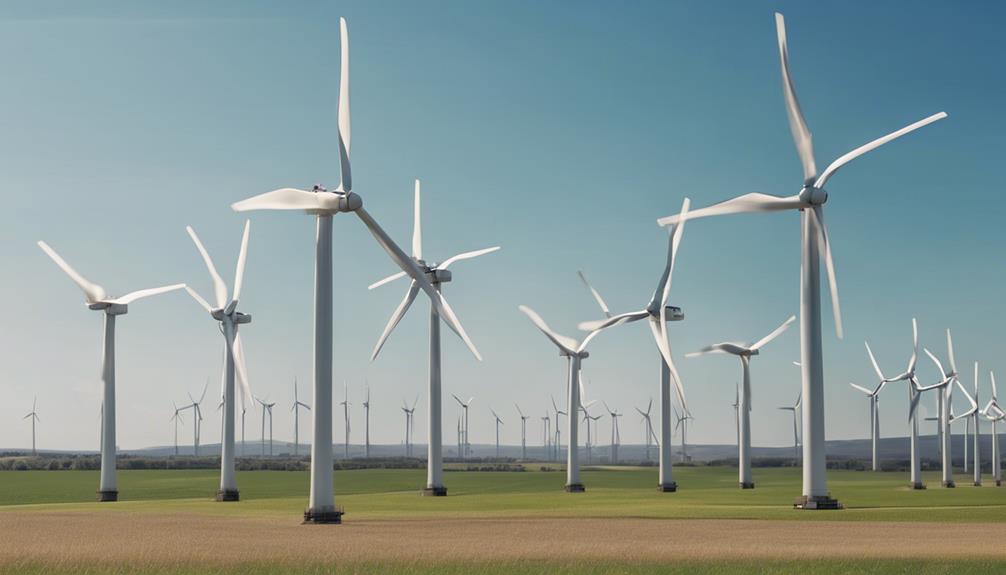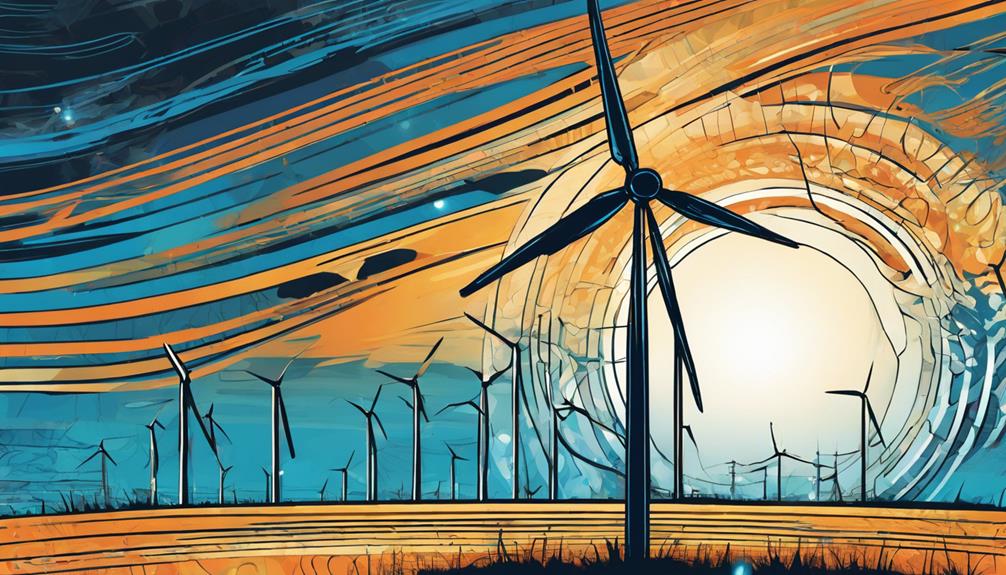Investigate how mechanical energy combines motion and position energy, with kinetic energy for motion and potential energy for position. Forces drive an object's movement and location within the domains of mechanical energy, where total energy remains constant. Witness the dynamic transformation of energy within systems and the conversion of mechanical energy for various applications. Immerse yourself into the preservation of total energy through the unyielding law of conservation. Mechanical energy fuels daily tasks and technological wonders, showcasing the versatility and power of this fundamental energy form. Discover the intricate dance between potential and kinetic energy forms within mechanical systems.
Key Takeaways
- Mechanical energy combines motion and position energies.
- Total mechanical energy is the sum of potential and kinetic energies.
- Machines convert mechanical energy for various applications.
- Conservation of mechanical energy maintains the total energy in a system.
- Understanding types of mechanical energy helps in energy transformation analysis.
What Is Mechanical Energy?
Mechanical energy is the combined energy of motion and position within an object. This energy encompasses both kinetic energy, associated with motion, and potential energy, related to an object's position. When considering mechanical energy, one must acknowledge the forces that govern an object's motion and position.
For instance, in an ideal simple pendulum, the interplay between kinetic and potential energy is evident as the pendulum swings back and forth. Conservation of mechanical energy dictates that the total energy within a system remains constant, emphasizing the balance between kinetic and potential energies.
Understanding mechanical energy involves observing the transfer of energy within a system. As an object moves, energy is constantly shifting between kinetic and potential forms, showcasing how mechanical energy is dynamic and ever-changing.
Types and Conversion of Mechanical Energy

To explore the domain of mechanical energy further, it's essential to understand the various types and conversions that play a pivotal role in harnessing and utilizing this dynamic form of energy. Here are some key points to keep in mind:
- Types of Mechanical Energy:
- Mechanical energy comprises potential energy (stored energy) and kinetic energy (energy of motion).
- The total mechanical energy of an object is the sum of these two components.
- Energy Conversion:
- Machines play a vital role in converting mechanical energy into different forms for diverse applications.
- This showcases the versatility of mechanical energy.
- Renewable Energy Sources:
- Renewable energy sources such as hydropower and wind energy heavily rely on mechanical energy conversion to sustainably generate electricity.
- Energy Conservation:
- Ensuring energy conservation in mechanical systems involves minimizing factors like friction and resistance.
- This helps prevent energy loss and maintain efficient operation.
Understanding these aspects of mechanical energy, including the law of conservation of mechanical energy, is fundamental in comprehending the dynamic nature of total mechanical energy within various systems.
Conservation of Mechanical Energy

Understanding the conservation of energy within mechanical systems is essential for analyzing energy transformations and predicting physical outcomes.
Conservation of Mechanical Energy refers to the principle that the total mechanical energy in a system remains constant. This means that energy can convert between potential and kinetic forms while the total mechanical energy is preserved.
In mechanical systems, energy transformations occur continuously, illustrating the interplay between potential and kinetic energy. The principle of conservation of mechanical energy plays a pivotal role in understanding how energy is transferred and distributed within systems.
For instance, in elastic collisions, where kinetic energy is conserved, the preservation of mechanical energy is evident. By grasping and applying the concept of energy conservation, you can effectively predict and analyze various physical phenomena.
Recognizing the relationship between potential and kinetic energy and how they contribute to the total mechanical energy in a system is fundamental in comprehending the behavior of mechanical systems.
Applications and Presence of Mechanical Energy

You encounter mechanical energy in your daily life through activities like running, driving cars, and using appliances. This energy powers machines and systems, allowing them to function efficiently.
Understanding how mechanical energy shifts between potential and kinetic states is essential for grasping its presence and applications.
Daily Energy Applications
Mechanical energy plays a significant role in powering various daily activities and technologies. Here are some examples of its applications:
- Daily Activities:
From biking to using kitchen appliances, mechanical energy is involved in numerous daily tasks.
- Shift Between Energies:
In activities like throwing a ball or riding a roller coaster, mechanical energy shifts between potential and kinetic forms.
- Machines:
Mechanical energy is vital for machines such as cars, elevators, and escalators, making our lives more efficient and convenient.
- Systems:
Systems like engines, generators, and conveyor belts rely on mechanical energy to operate smoothly and effectively.
Understanding how mechanical energy operates in these various applications can help optimize energy use in our daily tasks and technologies, ensuring that we make the most efficient use of this valuable resource.
Mechanical Energy Functions
The presence and applications of mechanical energy drive the functionality of numerous machines and devices in our daily lives. Mechanical energy, a combination of potential and kinetic energy, powers various processes and interactions. It plays a pivotal role in activities such as sports, where potential energy converts to kinetic energy to enable motion.
Appliances like refrigerators and cars also heavily rely on mechanical energy for their operations. Energy conversion is a key aspect of mechanical energy, allowing it to shift into different types of energy based on specific requirements. Gravitational force contributes significantly to the presence and utilization of mechanical energy in various systems.
This form of energy is essential for the operation of renewable energy sources like wind turbines and hydroelectric power plants, showcasing the versatility and importance of mechanical energy in sustainable practices. Understanding the types of mechanical energy and how energy transfers occur is essential for optimizing processes and enhancing efficiency in different applications.
Energy Loss and Impact of Kinetic Energy

You lose energy in collisions when they aren't elastic; energy can convert to other forms in these cases.
Collisions with nonconservative forces often lead to energy loss, changing the interaction's outcome.
The kinetic energy involved directly depends on speed variations, impacting the force of collisions.
Energy Loss in Collisions
During collisions, energy loss occurs as kinetic energy is transformed into other forms such as heat or sound, impacting the final outcomes and efficiency of the interaction. Understanding how energy dissipates in collisions is essential for comprehending the overall mechanical energy involved.
Here are some essential points to keep in mind:
- Inelastic Collisions: Inelastic collisions play a significant role in energy loss during impacts as kinetic energy isn't conserved due to the transformation into other forms.
- Nonconservative Forces: Collisions involving nonconservative forces like friction result in energy dissipation, affecting the overall efficiency of the interaction.
- Kinetic Energy Variations: Monitoring the changes in kinetic energy before and after collisions helps in predicting the outcomes and understanding the energy loss during the process.
- Conservation of Kinetic Energy: The conservation of kinetic energy principle is pivotal in evaluating the efficiency and outcomes of collisions, providing insights into how energy is distributed between the objects involved.
Kinetic Energy Impact
Objects undergoing collisions can experience energy loss due to the impact of kinetic energy and the nature of the collision itself, influencing the outcomes and dynamics of the interaction.
In collisions, the type of collision plays a significant role in determining energy loss. Elastic collisions, where kinetic energy increases and is conserved, contrast with inelastic collisions, where some energy is converted into other forms.
The energy involved in collisions can be dissipated due to various factors such as friction, external forces, and the characteristics of the collision. Understanding the impact of kinetic energy is essential as it affects the energy loss impact and the overall dynamics of the system.
The energy loss in collisions is influenced by the speed variations of the colliding objects, highlighting the importance of considering the kinetic energy impact when analyzing collision scenarios.
Definition and Types of Mechanical Energy

Mechanical energy is the combination of potential energy, which is stored energy, and kinetic energy, the energy of motion, within an object.
Understanding the types of mechanical energy can provide insight into how energy is transformed within systems:
- Gravitational Potential Energy: This type of potential energy is related to an object's position in a gravitational field. For instance, a ball held above the ground has gravitational potential energy due to gravity pulling it downward.
- Elastic Potential Energy: Elastic potential energy is stored in objects that can be compressed or stretched, like a spring. When a spring is compressed, it stores potential energy that can be released as kinetic energy when the spring is released.
- Energy of Motion: This is kinetic energy, associated with the movement of an object. The faster an object moves, the more kinetic energy it possesses.
- Total Mechanical Energy: The total mechanical energy of an object is the sum of its potential and kinetic energies. Understanding this concept can help analyze how energy shifts from potential to kinetic forms within a system.
Examples and Production of Mechanical Energy

The generation of mechanical energy through various processes exemplifies the dynamic interplay between different forms of energy. Examples of Mechanical Energy Production span a wide range of applications, showcasing the diverse ways in which mechanical energy is harnessed for various purposes. Engines, such as those in cars and planes, are prime examples of converting chemical energy stored in fuels into kinetic energy for motion. Hydroelectric Power Plants demonstrate the conversion of potential energy stored in water at a height into mechanical energy through turbines. Electric Cars utilize electrical energy stored in batteries to drive electric motors, thereby producing mechanical energy for propulsion. Roller Coasters ingeniously combine potential and kinetic energy to create thrilling rides. Wind Turbines are another excellent example, turning the kinetic energy of wind into mechanical energy that generates electricity. These examples highlight the intricate relationships between chemical energy, electrical energy, kinetic energy, and potential energy in the production of mechanical energy.
| Examples of Mechanical Energy Production | Energy Conversion | Application |
|---|---|---|
| Engines | Chemical to Kinetic | Cars, Planes |
| Hydroelectric Power Plants | Potential to Mechanical | Electricity Generation |
| Electric Cars | Electrical to Mechanical | Transportation |
Frequently Asked Questions
What Is a Simple Explanation of Mechanical Energy?
Mechanical energy is the total energy an object has due to its motion or position. It combines kinetic energy from movement and potential energy from position. Understanding this means grasping how these energies work together in systems.
How Do You Explain Mechanical Energy to a Child?
You explain mechanical energy to a child by showing how it's the energy that makes things move or stay still. Use examples like a swinging pendulum or a rolling ball. Show how it's all around us in everyday activities.
What Are the Three Forms of Mechanical Energy?
When thinking of mechanical energy, remember it's like a dance with three partners: kinetic energy, potential energy, and mechanical wave energy. Each plays an essential role in how things move and interact.
What Is the Rule of Mechanical Energy?
The rule of mechanical energy states that in a system with only conservative forces, the total mechanical energy remains constant. When non-conservative forces like friction act, energy loss occurs, violating this rule.
How Does Activation Energy Relate to the Concept of Mechanical Energy?
Mechanical energy is closely related to understanding activation energy factors. Activation energy is the minimum energy required for a chemical reaction to occur. In the context of mechanical energy, the amount of energy needed to initiate a physical process can be compared to activation energy in chemical reactions.
Conclusion
So there you have it – mechanical energy is all around us, from the spinning blades of a wind turbine to the bouncing basketball on the court.
This energy can be converted, conserved, and utilized in various ways to power our world. Just think about how a roller coaster uses mechanical energy to propel riders through loops and twists, creating an exhilarating experience for all.
Mechanical energy truly is a fascinating force at work in our everyday lives.









